Today’s consumers expect a smarter and more connected experience, and it’s increasingly a key competitive differentiator for all companies.
To exceed customer expectations, businesses need to leverage customer data; theoretically, this should be effortless given companies have access to more customer information than ever before — from social media to e-Commerce and beyond. But a recent Harvard Business Review (HBR) report, “Closing the customer experience gap,” found that businesses are still struggling to understand their customers.
Here are five key insights HBR uncovered from 680 executives around the world working to deliver superior customer experiences.
1. Despite the wealth of data, companies lack actionable insights
Leading companies are investing in databases and data warehouses to ingest internal and external sources of data, but many are discovering they’ve got more data than they can handle coming in from different systems and sources.
HBR found one global financial services company that houses all its own customer-related data in a centralized data warehouse has not yet been able to integrate behavioral data from websites or social media to get the whole picture. What’s more, very few companies have even begun using data coming from newer sources such as mobile apps, internet-connected devices, or wearables.
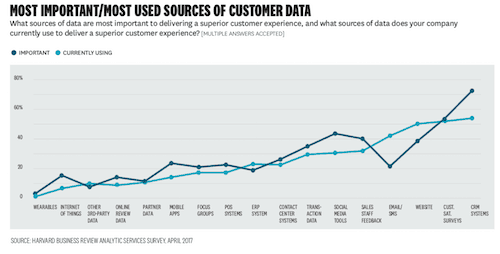
Graph categories from left to right: wearables; internet of things; other 3rd party data; online review data; partner data; mobile apps; focus groups; POS systems; ERP system; contact center systems; transaction data; social media tools; sales staff feedback; email/SMS; website; customer satisfaction survey; CRM systems.
If businesses are still working out how best to stitch together CRM systems and website data, it’s likely the situation will only worsen with expanding sources of customer data.
2. Leading businesses bring customer centricity to the whole enterprise
Companies that are successfully using customer data to tailor experiences report that a company-wide customer-centric focus is critical. What does this look like in practice? To start, it requires explicit executive support, a clear strategy, alignment and integration, investing in new technologies and skills, and empowering employees to innovate around customer experiences.
More tactically, one software solutions provider for logistics terminal operators reported the company created a customer experience role two years ago. It also operates with a “flattened organizational structure” (read: non-hierarchical) to enable more rapid responses to shifts in customer demands — the company believes its matrix structure has resulted in increased communication and empowered employees. One global financial service company is also replacing its structure with outcome-oriented teams, according to one of its customer experience leaders who is leading a team focused on customer journeys.
Other factors in delivering an effective customer experience include clarity around customer experience value/ROI, visibility of data across all functional areas, and more.
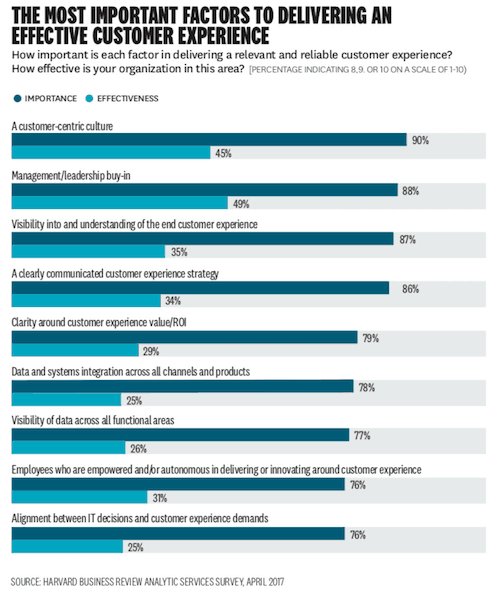
Graph categories from top to bottom: a customer-centric culture; management/leadership buy-in; visibility into an understanding of the end customer experience; a clearly communicated customer experience strategy; clarity around customer experience value/ROI; data and systems integration across all channels and products; visibility of data across all functional areas; employees who are empowered and/or autonomous in delivering or innovating around customer experience; alignment between IT decisions and customer experience demands.
3. Businesses are reinventing customer success measurement
Today, companies are more likely to measure customer experience effectiveness with customer satisfaction surveys (56%) than any other method. But customer satisfaction is only one metric leaders are using to measure the impact of their customer experience strategies; they are more likely to also consider customer lifetime value, customer advocacy, and customer retention to better understand customer behavior and develop more targeted strategies and tactics going forward.
One online fashion retailer explained how it also applies learnings from a combination of surveys, focus groups and individual interviews, CRM data, and online behavioral data to build a more holistic view of the results to effectively adjust customer experience efforts.
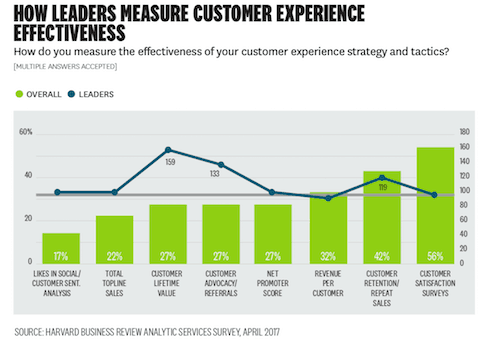
Graph categories from left to right: likes in social/customer sentiment analysis; total topline sales; customer lifetime value; customer advocacy/referrals; net promoter score; revenue per customer; customer retention/repeat sales; customer satisfaction surveys.
4. There are several barriers to gaining a single view of the customer
From organizational silos to data quality issues, there are several roadblocks preventing businesses from gaining a single view of the customer, impacting their ability to deliver personalized customer experiences. HBR found that only 13% of companies have a single, reliable source of customer intelligence across all products and activities today, and 30% are actively working on it.
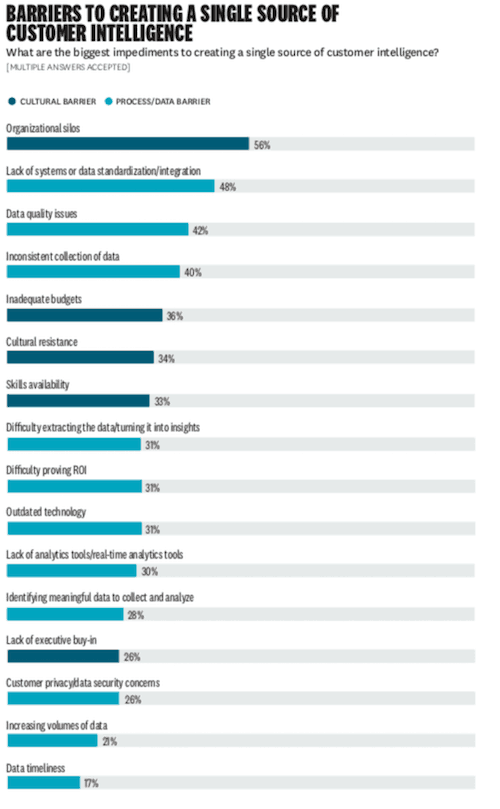
Graph categories from top to bottom: organizational silos; lack of systems or data standardization/integration; data quality issues; inconsistent collection of data; inadequate budgets; cultural resistance; skills availability; difficulty extracting the data/turning it into insights; difficulty proving ROI; outdated technology; lack of analytics tools/real-time analytics tools; identifying meaningful data to collect and analyze; lack of executive buy-in; customer privacy/data security concerns; increasing volumes of data; data timeliness.
Companies are also struggling to integrate data in legacy systems with new sources of customer data to streamline and distribute insights throughout the organization in a meaningful way. MuleSoft’s own digital transformation research found demands for integration now span beyond the IT department for almost all (92%) organizations — ranging from business analytics to HR and marketing — and IT leaders reported a 32% increase in the number of projects they are being asked to deliver. Difficulties connecting numerous systems is not only placing pressure on IT, but hindering business productivity and innovation.
5. IT and business must partner to overcome challenges
The role of IT is changing in this digital age. HBR reports nearly three-quarters of business leaders (73%) said delivering a relevant and reliable customer experience is critical to their company’s overall business performance today, and almost all (93%) agreed that it would be two years from now.
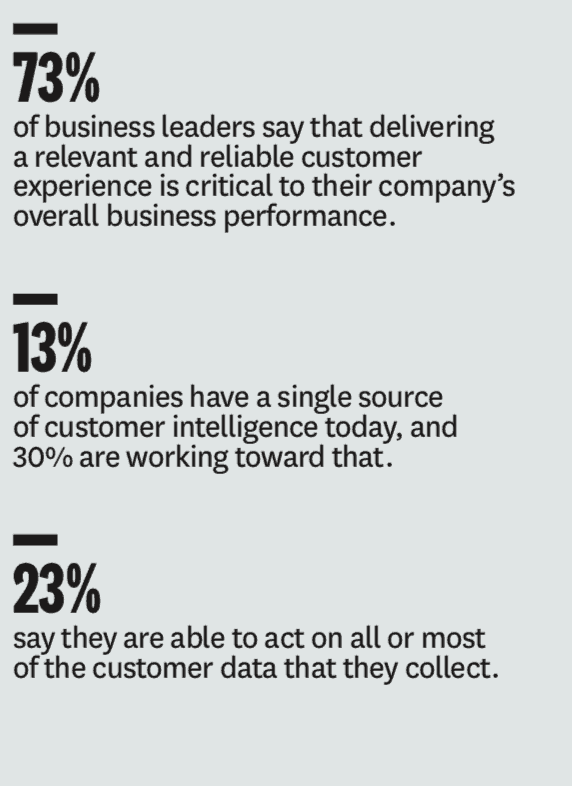
In order to deliver on the capabilities customers crave, the most effective digital enterprises are shifting the dynamic between business and IT. Rather than living with the legacy of IT servitude, digitally mature organizations recognize that if digital products and services are core to their business, then IT is a core part of the business organization. HBR’s report underscores this, noting, “companies with leaders that have not bought into the value of an integrated and all-encompassing customer experience foundation find their efforts lack the clarity, budgetary support, and organizational structures to drive customer-focused transformation.”
For more on HBR’s research and industry trends, download the full Closing the customer experience gap report.









